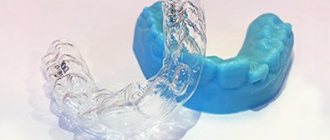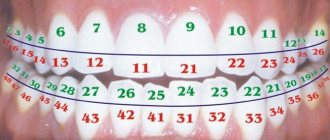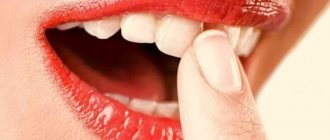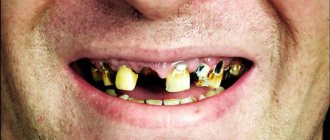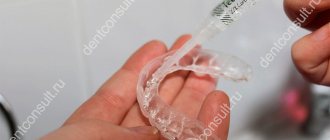“You urgently need to remove the 48th tooth!” - such a statement from the dentist can seriously puzzle the patient, because even from a school biology course everyone knows that there are only thirty-two teeth in the mouth. Where did this mysterious 48th come from, and what is with the strange numbering of teeth among dentists? Cunning doctors have invented a diagram of a person’s teeth with numbers that only they understand, and patients get confused in these numbers, trying to understand what they are talking about and where they suddenly got “extra” dental units from.
In fact, the teeth numbering scheme in dentistry is quite simple, clear and accessible - it was created in order to facilitate the “accounting” of dental units in patients and bring it to some uniform standards. After all, if every dentist starts counting dental units as he pleases, nothing good will definitely come of it. Especially if the patient subsequently gets an appointment with another doctor and he simply does not understand what tooth numbers are indicated in the medical record and what kind of treatment was ultimately carried out earlier.
Location of teeth by numbers
Despite all the individual characteristics of each person, the location of the teeth and their name are the same for everyone. This is explained by the fact that dental elements begin to form long before birth (approximately 2-3 months of embryogenesis), and at birth the child has all the dental buds located deep in the jaw.
In both adults and children, the dentition is symmetrical - the upper and lower jaws have the same number of teeth of the same name (the reference point is the midline of the face).
The table shows the order of the teeth and their correct name.
| Serial number | Dairy | Permanent |
| 1 | central incisor | central incisor |
| 2 | lateral incisor | lateral incisor |
| 3 | fang | fang |
| 4 | first molar | first (small) premolar |
| 5 | second molar | second (small) premolar) |
| 6 | — | first (large) molar |
| 7 | — | second (large) molar |
| 8 | — | third (large) molar |
As can be seen from the table, only the front teeth (incisors and canines) have the same names and locations in children and adults. The rear (or “root”) have significant differences.
Possible eruption disorders
The reasons that should force parents to see a dentist and orthodontist are different. But as a rule it is:
- Loss of a baby tooth prematurely or out of order. The cause may be physical trauma or tooth decay due to caries. The loss itself is not a serious problem. But it may be necessary to install a temporary prosthesis in place of a baby tooth until the permanent one erupts. After all, a child’s jaw is just forming and if nothing interferes with the neighboring teeth, they can shift towards the resulting void. And this will lead to the fact that there is simply not enough space for the future molar.
- The opposite situation is when the baby tooth has been sitting too long. The molar is already cutting under it, but it cannot push it out. In this case, the baby tooth must be removed by a dentist. However, please note that you should rush to remove it only if the molar erupts on top of the milk tooth. If the root one is not visible, and nothing causes discomfort, then there is no need to pull out the milk one. Since there may simply be no molar rudiment under the tooth, and then the baby tooth will remain that way for life.
Depending on the developmental characteristics of the child, both milk and permanent teeth may come out a little later than the standard period. If a baby tooth does not erupt, the reason may be an intrauterine infection that could affect the tooth germ. If it has erupted, but does not tend to fall out, this is a standard deviation. The dentist will take an x-ray, and if there is no molar rudiment, then there is no need to touch the baby tooth.
Why is tooth numbering necessary?
All human teeth have their own specific location according to numbers. But how can you understand whether it is located on the upper or lower jaw, or on the left or right? You can use full formulations (for example, the first permanent molar of the upper jaw on the right). But such cumbersome names create certain difficulties for dentists and can often cause mistakes, which are especially dangerous if the patient is undergoing extraction of a diseased tooth.
In order to optimize the work of doctors and simplify the designation of tooth numbers as much as possible, special numberings were invented.
Scheme for adults
The adult system can be divided. Unit numbers are determined for the lower and upper jaws based on center to right and center to left. The first two incisors in dentistry are numbered as No. 1 and No. 2. There are eight incisors in total. Under No. 3 are the fangs, there are four in total. Then numbers 4 and 5 follow - these are premolars. Numbers 6 and 7 are molars and other chewing units. The last units of the dentition, which dentists call “eights,” grow later than others. You may notice that the names are not clear and vague. Therefore, having heard about the need to fill molar number 7, it is impossible to determine exactly which tooth, on the right or left, is meant and on which jaw it is located. Digital designation undoubtedly simplifies the work of doctors, but there is still a division of the jaw into segments. The parties are determined not by the patient, but by the doctor. Teeth numbering in dentistry, photo diagram can be found on the Internet. Dentists use similar products in their daily activities.
Tooth numbering schemes in dentistry
Currently, tooth numbers in dentistry are systematized according to several schemes:
- Universal numbering system.
- Square-digital or Zsigmondy-Palmer system.
- Haderup system.
- American numbering or alphanumeric system.
- European numbering Viola or WHO system.
Let's take a closer look at the features of each of them.
Universal system
This numbering scheme is based on assigning each permanent tooth a specific number from 1 to 32. In primary occlusion, each tooth has its own letter. In this case, the count is carried out from the right half of the upper jaw clockwise from the wisdom tooth.
The dental formula of a permanent set according to the universal system looks like this:
Milk teeth are marked according to the same principle, but only using letters of the Latin alphabet:
Zsigmondy-Palmer system
This numbering is the most imperfect, since it still indicates the teeth under numbers without a more precise indication of their location. At the same time, Arabic numerals from 1 to 8 are used for the permanent set, and Roman numerals (IV) are used for numbering dairy products.
The digital system does not exclude errors when carrying out diagnostic or therapeutic measures, therefore, today it is used only by orthodontists (for example, when installing and marking braces) or maxillofacial surgeons. And entries on it in the patient’s medical record are made only on a special diagram.
Haderup system
Numbering according to the Haderup system also applies to digital numbers. To designate the teeth of an adult, Arabic numbers 1-8 are used with a plus or minus sign in front of them. The “+” sign is used to number the upper ones, and the “-” sign to indicate the lower ones.
The numbers of children's teeth are similarly written in Arabic numerals with the signs “+” or “-”, but at the same time the number “0” is placed in front of them.
The inconvenience of such a system is the need to indicate the location of the tooth on the left or right side of the jaw.
American alphanumeric system
This numbering is widespread in the USA. The alphanumeric system is based on assigning a letter value to each group of teeth (capitals for a permanent set, and capitals for a primary set), as well as a digital code that indicates the location of the tooth in a correct bite.
Letter meanings of teeth:
- I (i) - permanent (deciduous) incisors;
- C (s) - permanent (deciduous) fangs;
- P - premolars (absent in primary dentition);
- M (m) - permanent (deciduous) molars.
American numbering also does not take into account the left- or right-sided position of the tooth, which can cause certain difficulties.
European international numbering Viola
Today, this is the newest and most advanced teeth numbering system. Its essence lies in the fact that the jaws are divided into segments (2 on top and 2 below), each of which is assigned its own number. For adults, numeric values are used 1-4, and for children - 5-8. As a result, each tooth receives a two-digit number, the first digit of which indicates a specific segment, and the second - a serial number.
The convenience of the Viola system lies in the absence of cumbersome names while accurately indicating the location of the required tooth and the minimal risk of error. This numbering is indispensable when sending a patient for an x-ray, as well as when identifying teeth on a panoramic image.
Children's dental chart
The given counting system cannot be used to count baby teeth. It is valid only for permanent ones. To avoid confusion in the future, a different jaw segmentation scheme is used, but the serial numbers remain the same. That is, the incisors are still assigned the numbers 1 and 2, and the clicks are assigned the number 3. Let’s find out which tooth numbers dentistry uses in children’s counting schemes.
Segments:
- top right - first (marked as 50 in entries);
- top left - second (marked 60 in records);
- bottom left - third (marked 70 in records);
- the bottom right is the fourth (marked as 80 in the records).
Numbers are assigned clockwise. But the children's counting scheme can cause difficulties due to the incompleteness of the dentition.
How to determine the tooth number - practice with examples
Determining which teeth numbers are quite simple, you just need to practice a little with examples.
Tooth number 37 - which one is it?
To an unknowing person who is not familiar with the numbering systems in dentistry, it may seem that we are talking about an extra 5 teeth in the mouth. But that's not true. According to the Viola system, teeth with numbers starting with three are located on the lower jaw on the left. And serial number 7 corresponds to the second molar. This means the 37th tooth is the second lower molar on the left.
What number corresponds to the upper right wisdom tooth (eight)?
The third molar will be designated differently in different systems.
- In the universal number scheme - number 1.
- According to the Zsigmondy-Palmer scheme - “upper right eight”.
- According to the Haderup system - “+8 on the right”.
- In the American scheme - “upper M3 on the right”.
- According to the Viola system - number 18.
For a school-age child, the dental formula says that next to tooth 21 there is tooth 62. How can this be?
In children at 6-7 years old (less often at 8-9 years old), the replacement of milk teeth begins. Therefore, both teeth from a temporary set and already erupted permanent teeth can be located in the mouth at the same time. In this situation, they are numbered according to the Viola system, and their numbers indicate that the central upper incisor on the left (number 21) has already been replaced by a molar, but the lateral incisor is still from the primary bite (therefore it is marked under number 62).
Features of treatment of individual groups of teeth
The treatment tactics for incisors, canines, premolars, molars of the upper and lower jaws are different. Each tooth carries a different load. One part of the row is visible when you smile, while the other remains invisible to others. Let's look at the features of treatment for each area of the oral cavity.
Treatment of wisdom teeth
Eights are the outermost molars in the row. They erupt later than others, practically do not participate in chewing food, and regularly cause trouble. 1, 16, 17, 32 teeth can erupt incorrectly, displacing the entire row, injuring the gums, and causing the formation of a soft tissue hood. This increases the risk of plaque accumulation and tooth decay.
| Features of wisdom teeth treatment | |
| Question | Dentist recommendation |
| Do I need to remove wisdom teeth? | In most cases, this is necessary and recommended. |
| Is it possible to treat caries on the 8th tooth? | If they do not disturb the structure of the dentition or cause discomfort, then after consultation with a doctor you can do this. |
In most cases, eights must be removed. If they grow at an angle, disrupt the bite, displace other molars, cause discomfort, or have underdeveloped enamel, it is recommended to get rid of them as quickly as possible. Extraction of teeth 1, 16, 17, 32 does not affect the chewing function or appearance of the patient.
Is caries of eights curable? If they have a normal structure, do not cause discomfort, and are involved in chewing, superficial caries can be treated using the traditional method - drilling, installing a filling. The procedure is performed at the request of the patient. If a person refuses conservative therapy, the extreme molars are removed.
If there is significant damage to the visible part of the figure eights, their removal is indicated. Artificial crowns are not installed on them due to their location and anatomical features. For acute pain, the only way to solve the problem is extraction. The figure eights are located in the far corners of the oral cavity, which makes depulpation and endodontic treatment impossible. Lack of visibility and access to instruments prevents nerve removal and canal filling.
Extreme molars are unreliable and often destroyed, so they are not recommended for use as a support for bridges. If eights are lost, prosthetics are not performed; there is no such need or possibility.
Treatment of molars
2, 3, 14, 15, 18, 19, 30, 31 teeth are molars that bear the main load when chewing. They are large, with a wide crown, have several roots, so they are firmly held in the jaw. They are not visible when you smile, but the defeat or absence of one of them causes severe discomfort to the patient. When treating this group, they pay attention to strength and strive for complete restoration of function.
| Features of treatment of molars | |
| Question | Dentist recommendation |
| What treatment methods are there if a molar is severely damaged? | In case of severe destruction of molars, ceramic inlays are most often used. |
| Which crowns are best for molar prosthetics? | More often, patients are recommended to install metal-ceramic crowns in the molar area. |
| What to do if you lose molars? | The best option in this case is implantation; patients also consider removable dentures. |
The main method of treating caries of sixes and sevens is drilling and filling. If the process does not affect the canal with the neurovascular bundle, the doctor drills out the affected areas and closes the defect with a filling made of composite materials. If the affected area is large, it is advisable to use ceramic inlays. They are made from impressions for each patient and close the cavity formed after treatment. The use of inlays allows you to increase the service life of the molar and ensures its resistance to chewing loads.
If the visible part of the six or seven is significantly destroyed, but the root is preserved, restoration is carried out using a crown. The best material for prosthetics of 2, 3, 14, 15, 18, 19, 30, 31 teeth is metal ceramics. Such designs are very durable and allow you to chew even hard food. A thin strip of metal that is visible between the metal-ceramic crown and the gum is not a disadvantage when restoring molars. It is completely invisible because these teeth are not located in the smile area. You can choose crowns made of zirconium dioxide, but they will cost more than metal-ceramics. Ceramic structures are not installed on chewing teeth.
The loss of molars affects the condition of the gastrointestinal tract and leads to displacement of the entire dentition, so prosthetics are necessary. To replace 6-k bridges, bridges are often used. If nearby units can serve as support, this is the fastest, least expensive, painless option for restoring mastication. For multiple defects, removable clasp and plate prostheses are used.
The optimal way to replace molars is implantation. The condition of adjacent teeth does not matter. With the help of titanium structures, it is possible to restore both one and several units. In most cases, root-shaped prostheses are used for prosthetics. They are able to withstand heavy loads. Such implants can serve as a support for artificial crowns and bridges.
Treatment of premolars
Teeth 4, 5, 12, 13, 20, 21, 28, 29 are premolars. They also perform the function of chewing, but are not as large and massive as molars. Some premolars are located in the smile zone, so when treating them, not only strength and functionality are important, but also beauty and naturalness.
| Features of treatment of premolars | |
| Question | Dentist recommendation |
| What to do if premolars are destroyed? | In case of significant destruction, ceramic inlays or crowns are used. The best material for premolar restoration is zirconium dioxide. |
| What to do if there are no premolars? | In this case, there are several treatment options - bridge structures, butterfly prosthesis or implantation of a missing tooth. |
The most common lesion of fours and fives is caries. Destruction occurs especially often in patients with deep fissures and narrow interdental spaces.
Due to the location of small molars, caries on them can be noticed in the initial stages. Sometimes even patients themselves pay attention to the problem and seek dental help. If a carious lesion is detected at the spot stage, modern clinics carry out treatment without drilling using the ICON system. Careful removal of damaged enamel using an etching gel allows you to save the tooth, and sealing the cavity with a special compound stops further destruction. For deeper lesions, destroyed tissue is removed using a drill or laser. Small defects are restored with durable photopolymer materials. You can choose the shade of the filling that perfectly matches the color of the enamel. In case of significant destruction, leading dentists recommend using ceramic inlays, which are made in a dental laboratory using individual impressions.
The destroyed outer part of the premolar is an indication for the installation of crowns. If only the root remains, a stump tab is installed to securely secure the prosthesis. The choice of crown material depends on the financial capabilities of the patient. The best choice is zirconium dioxide. Such designs are aesthetic and resistant to chewing loads. Their only drawback is their high price. Metal ceramics are available to everyone. It is strong and durable, but the strip of metal under the gum can be very noticeable for some. Ceramics are not suitable for fours and fives. This material is too fragile; with intensive chewing, chips will quickly appear on it.
The absence of premolars in a person is immediately noticeable to others. When they are lost, most turn to dentistry for prosthetics. If you want to quickly restore chewing and restore an attractive smile, installing an inexpensive bridge will help. The design consists of several interconnected crowns made of metal ceramics or zirconium dioxide. The outer crowns are placed on the supporting teeth, and the middle ones cover the defect in the dentition. The main disadvantages of this type of prosthetics are the need to grind healthy teeth and uneven distribution of load on the jaw.
If installing a bridge is not possible, the prosthetist will suggest a removable clasp prosthesis. Typically, the design is used when several teeth are missing. This method saves the budget and has virtually no contraindications. Lightweight butterfly prostheses are used to temporarily replace the defect. They last no more than six months, but this is enough for patients who are awaiting the manufacture of a permanent prosthesis or implantation.
The best method of replacing a lost premolar is implantation. If there are no contraindications and your budget allows, it is better to choose this modern method. A titanium rod is inserted into the jaw bone tissue and becomes a support for an artificial crown. To install such a prosthesis, you do not need to grind down the adjacent teeth. In addition, the load during chewing is distributed physiologically. Externally, an artificial premolar is difficult to distinguish from your own. Even a dentist will not always do this at first glance.
When treating 4- and 5-k, it is important to maintain a balance between practicality and aesthetics. For this reason, this group is the most difficult for dentists.
Treatment of fangs
There are four fangs in the oral cavity. These are 6, 11, 22, 27 teeth according to the universal numbering system. They have a different shape from other teeth, so during restoration it is necessary to have experience working with this group.
| Features of canine treatment | |
| Question | Dentist recommendation |
| What treatment options are there for lost fangs? | In this case, implantation of the lost canine is recommended. |
| How can you correct abnormally growing fangs? | After consultation, the patient is offered options for either orthodontic treatment or the installation of veneers or crowns. |
The fangs do not bear the chewing load. They help you bite off small pieces of food. In the process of evolution, the role of fangs in humans was lost; we do not use them to hold food or tear it into fragments. That is why the treatment of triplets is aimed at restoring their natural appearance.
In case of carious lesions, the preparation of fangs is carried out carefully, trying to preserve healthy tissue as much as possible. This will allow for high-quality restoration. With superficial caries, it is possible to preserve the volume of hard tissue necessary for high-quality filling, but deep lesions serve as an indication for installing a crown. To maintain a natural smile, it is recommended to use structures made of ceramics or zirconium dioxide.
If 6, 11, 22, 27 teeth are lost, implantation is recommended. Manufacturers offer titanium prostheses of a special configuration, taking into account the anatomical features of the jaw. Such prostheses are already classic, they have a special thread that allows you to securely fasten the structure in the narrow alveolar process.
A popular dental service is canine shape correction. Some patients have teeth that are too long, pointed, or significantly narrower than the incisors, which makes the smile less attractive. The best way to give the fangs the ideal shape is to use ceramic onlays made from individual impressions, as well as modeling with composite materials.
Numbering for an abnormal number of teeth
If a person has a normal number of teeth in his mouth, then their numbering does not cause difficulties and remains constant both at a young age and after 60 years.
If some teeth are lost (for example, due to various diseases or developmental anomalies), then in the dental formula next to the corresponding number its absence is simply indicated.
But there are diseases of the dental system, which are characterized by an increase in the number of teeth with an atypical arrangement. With such options, the use of any numbering schemes is difficult and most often dentists refuse to use them. In this case, complete information about the number of teeth, their description and location is entered into the patient’s medical documentation.
Biochemical composition of the tooth
Since the parts of any tooth differ in their functions, they will also differ in their biochemical composition.
The main composition of the entire tooth is water, organic and inorganic compounds. In particular, individual important components are mineral components.
Enamel is a hard, mineralized tissue. Its strength is determined by a high degree of mineralization.
Dentin is a mineralized tissue that does not have cells or vessels. Forms the bulk of the tooth. The structure is similar to both enamel and bone tissue of the body.
Pulp is a connective tissue consisting of cells and intercellular substance. The pulp performs one of the important functions: it participates in the formation of dentin and provides the central nervous system with the necessary information about the condition of the enamel and the tooth as a whole, which explains the high sensitivity of the teeth.
Mineralization is a process by which an organic base is formed and saturated with calcium salts, if present in the body. This is an intensive process that occurs during the period of teething and the formation of dentin and enamel, since initially the tooth has non-mineralized enamel.
Changing baby teeth
The process of changing the bite begins much earlier than the first tooth falls out. Over time, baby teeth no longer hold tightly to the gums and begin to loosen. And this happens due to the fact that the roots of such teeth are formed from tissue that can dissolve over time. But only if the germ of a permanent tooth appears.
The germ of the future tooth is separated from the root of the milk tooth by just a thin bone plate. If it forms, it will begin to put pressure on this bone septum. Osteoclasts will begin to appear in the surrounding tissue, which are designed to destroy it.
From this moment on, the process of changing one tooth to another occurs from two sides: the permanent one destroys the enclosing plate, and the pulp of the baby tooth begins to turn into tissue rich in blood vessels and the same osteoclasts that destroy the dentin of the baby tooth. As a result, the root is absorbed, and only the neck with the crown remains, which are easily removed during the growth of a new tooth.
The famous "polyodont" Freddie Mercury
Some people can be different from others in unexpected ways. For example, the eternal and unforgettable lead singer of Queen had a non-standard teeth pattern - 36 instead of the “generally accepted” 32.
Malocclusion was one of his calling cards. It was caused by polyodontia - a defect acquired from birth, in which a person has a supernumerary set of teeth. Freddie did not resort to surgery until his death, as he was afraid that the corrected bite could change his voice.
In modern realities, the singer would have had his “extra” teeth removed and then undergone orthodontic adjustments. The whole process would take no more than six months (despite the fact that the use of aligners or lingual braces would make the treatment completely invisible to others).
Any dental problem can be solved; the only condition is timely and accurate diagnosis.
The iOrtho clinic network provides high-quality services for correcting malocclusion with Invisalign aligners, sign up for a consultation now!
Molar tooth extraction
Removing any teeth is a very serious procedure. And removing a tooth six is also unpleasant. Any adult will find it difficult to endure such an intervention, and even more so a child. No matter how well the equipment and anesthesia are selected, no matter how competent the doctor is, swelling of the tooth socket and surrounding tissues cannot be avoided. Moreover, the method of removing such teeth involves their loosening, which can negatively affect neighboring teeth.
They are removed only for serious reasons. Any competent dentist will try to save the tooth. Removal is prescribed in two cases. Or the tooth interferes with the normal growth of other teeth and can cause the bite to deteriorate. Or it can harm the body in case of serious damage from caries.
